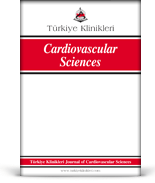Amaç: Kronik venöz hastalık (KVH), günlük yaşamı etkileyen, tanı ve tedavi maliyetinin yüksek olduğu bir sağlık sorunudur. Bu çalışmada, KVH tanısına sahip klinik, etiyolojik, anatomik, patofizyolojik [clinical-etiological-anatomical-pathophysiological (CEAP)] sınıflamasına göre C1s/a olan hastalarda, radyofrekans (RF)ın tedavideki etkinliğinin tespit edilmesi amaçlanmıştır. Gereç ve Yöntemler: Bu çalışma, KVH nedeniyle 2018-2019 yılları arasında Erciyes Varis Tedavi Merkezine başvuran, CEAP sınıflamasına göre C1s/a olan hastalar dâhil edilerek yapılmıştır. Hastalar, uygulanan tedavi yöntemlerine göre 2 gruba ayrıldı. Grup 1'deki hastalara; 27.12-MHz RF tedavisi, venoaktif ilaç [venoactive drug (VAD)] tedavisi (kalsiyum dobesilat), işlem sonrası kompresyon tedavisi ve antistaz egzersiz tedavileri uygulanmıştır. Grup 2'deki hastalara ise VAD tedavisi (kalsiyum dobesilat), kompresyon tedavisi (Class 1) ve antistaz egzersiz tedavileri uygulandı. Bulgular: Çalışmaya, medyan yaşı 41 (35,25-46) olan 61 (%50,8)'i kadın ve 59 (%49,16)'u erkek, toplamda 120 hasta dâhil edildi. Grup 1'deki hastaların yaşlarının medyan değeri 40 (33,25-44), Grup 2'deki hastaların ise 42 (37-49,5) olarak bulundu. Hastalar, semptomatik olma durumuna göre incelendiğinde 96 (%80) hastanın asemptomatik, 24 (%20) hastanın ise semptomatik olduğu tespit edildi. Semptomlarda ise en sık ağrı (%25) ve bacak şişliği (%15) görüldü. Sonuç: KVH'nin primer tedavisi, hastaların eğitimi ve yaşam tarzı değişiklikleridir. KVH'de kompresyon çorapları ve medikal tedavinin yanında RF, hastaların klinikleri üzerine olumlu etki gösterebilecek alternatif bir tedavi yöntemi olarak düşünülebilir.
Anahtar Kelimeler: Venöz yetmezlik; radyofrekans; telenjiektazi
Objective: Chronic venous disease (CVD) is a health problem that affects daily life and has a high diagnosis and treatment cost. In this study, it was aimed to determine the efficacy of radiofrequency (RF) in patients with C1s/a according to clinical-etiologicalanatomical-pathophysiological (CEAP) classification with CVD diagnosis. Material and Methods: This study was conducted by including patients with C1s/a according to the CEAP classification who applied to Erciyes Varicose Treatment Center between 2018-2019 due to CVD. The patients were divided into 2 groups according to the treatment methods applied. Patients in Group 1; 27.12-MHz RF therapy, venoactive drug (VAD) therapy (calcium dobesilate), post-procedure compression therapy and antistase exercise treatments were applied. VAD therapy (calcium dobesilate), compression therapy (Class 1) and antistase exercise treatments were applied to the patients in Group 2. Results: A total of 120 patients, 61 (50.8%) female, 59 (49.16%) male, with a median age of 41 (35.25-46) were included in the study. The median value of the ages of the patients in Group 1 was 40 (33.25-44), and 42 (37-49.5) in the Group 2. When the patients were examined according to their symptomatic status, it was found that 96 (80%) patients were asymptomatic and 24 (20%) patients were symptomatic. Among the symptoms, pain (25%) and leg swelling (15%) were the most common. Conclusion: Primary treatment of CVD is education and lifestyle changes of patients. In addition to compression stockings and medical treatment in CVD, RF can be considered as an alternative treatment method that can have a positive effect on patients' clinics.
Keywords: Venous insufficiency; radiofrequency; telangiectasia
- Kaplan RM, Criqui MH, Denenberg JO, Bergan J, Fronek A. Quality of life in patients with chronic venous disease: San Diego population study. J Vasc Surg. 2003;37(5):1047-53.[Crossref] [PubMed]
- Çınar Özdemir Ö, Altındağ E, Avcı F, Uysal MF. [Chronic venous insufficiency]. Türkiye Klinikleri J Health Sci. 2016;1(2):125- 38.[Crossref]
- Beebe-Dimmer JL, Pfeifer JR, Engle JS, Schottenfeld D. The epidemiology of chronic venous insufficiency and varicose veins. Ann Epidemiol. 2005;15(3):175-84.[Crossref] [PubMed]
- Magnusson MB, Nelzén O, Risberg B, Sivertsson R. A colour Doppler ultrasound study of venous reflux in patients with chronic leg ulcers. Eur J Vasc Endovasc Surg. 2001;21(4):353-60.[Crossref] [PubMed]
- Kakkos SK, Rivera MA, Matsagas MI, Lazarides MK, Robless P, Belcaro G, et al. Validation of the new venous severity scoring system in varicose vein surgery. J Vasc Surg. 2003;38(2):224-8.[Crossref] [PubMed]
- Cataldo JL, de Godoy JM, de Barros N. The use of compression stockings for venous disorders in Brazil. Phlebology. 2012;27(1):33-7.[Crossref] [PubMed] [PMC]
- Bozkurt K. Türk Kalp Damar Cerrahisi Derneği Periferik Arter ve Ven Hastalıkları Tedavi Kılavuzu. Ankara: Öncü Basımevi; 2008. p.97-123.[Link]
- Kim DH, Larouche D, Germain L. Clinical study of 27.12-MHz radiofrequency treatment for cutaneous vascular lesions. Convention de recherche LOEX 2013-001. Entre le LOEX et Dectro International. 2013.[Link]
- De Backer G. Epidemiology of chronic venous insufficiency. Angiology. 1997;48(7):569-76.[Crossref] [PubMed]
- Seidel AC, Belczak CE, Campos MB, Campos RB, Harada DS. The impact of obesity on venous insufficiency. Phlebology. 2015;30(7):475-80.[Crossref] [PubMed]
- Yılmaz S, Yaylacı S, Diken Aİ, Yalçınkaya A, Aksoy E. [Compression stockings and the factors that affect their use in lower extremity venous insufficiency treatment]. Damar Cer Derg. 2015;24(1):47-53.[Crossref]
- Kakkos SK, Timpilis M, Patrinos P, Nikolakopoulos KM, Papageorgopoulou CP, Kouri AK, et al. Acute effects of graduated elastic compression stockings in patients with symptomatic varicose veins: a randomised double blind placebo controlled trial. Eur J Vasc Endovasc Surg. 2018;55(1):118-25.[Crossref] [PubMed]
- Iriz E, Vural C, Ereren E, Poyraz A, Erer D, Oktar L, et al. Effects of calcium dobesilate and diosmin-hesperidin on apoptosis of venous wall in primary varicose veins. Vasa. 2008;37(3):233-40.[Crossref] [PubMed]
- Androulakis G, Panoysis PA. Plethysmographic confirmation of the beneficial effect of calcium dobesilate in primary varicose veins. Angiology. 1989;40(1):1-4.[Crossref] [PubMed]
- Kim DH, Hyun DJ, Piquette R, Beaumont C, Germain L, Larouche D. 27.12 MHz radiofrequency ablation for benign cutaneous lesions. Biomed Res Int. 2016;2016:6016943.[Crossref] [PubMed] [PMC]
- Kim SH, Roh SG, Lee NH, Yang KM. Radiofrequency ablation and excision of multiple cutaneous lesions in neurofibromatosis type 1. Arch Plast Surg. 2013;40(1):57-61.[Crossref] [PubMed] [PMC]







.: İşlem Listesi